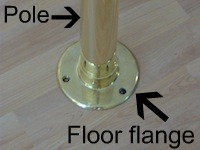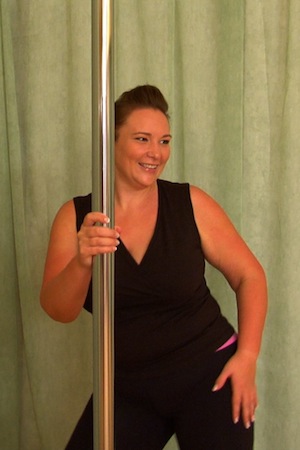Permanent Dance Pole
Safety Info & Tips
Home > Permanent Pole Info > Permanent Dance Pole Safety
Many people think that safety is not a concern with permanent dancing poles. After all, they're screwed into both the floor and ceiling, so what could go wrong?
But while it's true that the permanent version is generally safer than any other model of pole, there are still some safety issues that should be considered.
 |
The reason that a permanent dance pole is so safe is that the tubing is fitted inside both a flange at each end, both of which are then attached with 3 or 4 screws into the ceiling and the floor. But to get the safety benefits of the permanent mounting system, it's critical to follow the manufacturer's installation instructions. |
For example, the ceiling flange must be installed into a ceiling joist or support beam (sometimes also called a "stud" or a "2 by 4").
The floor must also offer a secure installation point for the floor flange, and the manufacturer's instructions will tell you exactly what you need to do to ensure this.
If you're unsure, call the customer support number that any reputable manufacturer or retailer will supply.
Permanent Dance Pole = Highest Weight Limit
Permanently affixed poles generally have the highest weight limit of all the different options. Because they are permanently attached to the floor and ceiling, they can usually handle more weight and more force than any of the other options.
 |
For this reason, many plus size women who are concerned about weight limits prefer a permanent pole dancing pole. In fact, anyone who wants to have the strongest possible setup will probably look at this type of pole as an option. Be aware, however, that any structure is only as strong as its weakest part. Just because your equipment is bolted to floor and ceiling, doesn't mean it can't break or bend. |
If the material used to construct the tubing is soft (brass is softer than stainless steel for example), your ceilings are very high, and/or the tubing material is thin, one or a combination of these factors can make for an unsafe setup, even though your pole may be bolted into place.
You'll find more detailed information on these important considerations on this page, which can help you understand how different factors can impact the strength of your pole.
Safety - An Ounce of Prevention...
Even with high quality permanent dancing poles, it's important not to take safety for granted. You should check the floor and ceiling flanges (including the screws) regularly for any loosening or wear.
Also, check the set screws or rivets that secure the tubing to the flanges. These stop the pole from unintentionally rotating, which can be very dangerous if you're not expecting it!
Of course, just because a permanent mounting system is potentially more safe than your other options, doesn't mean those other options are unsafe!
In fact, if installed and used according to the manufacturer's instructions, all types of poles are relatively safe, as long as you play within the limits of your pole's specific design, and take your own fitness level into account.
Safety Recap - Permanent Dancing Poles
- Ensure correct installation by securely screwing the flanges into floor and ceiling joists.
- Check the floor and ceiling flanges regularly for any loosening or wear, and tighten screws if necessary. Replace damaged flanges or stripped screws right away.
- Ensure that the tubing length, diameter, thickness and construction material are of suitable quality to withstand the intended load.
- Check the set screws or rivets that secure the tubing to the flanges, and tighten if necessary to avoid unintentional rotation.
